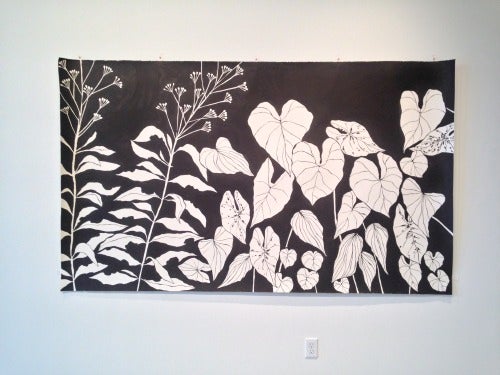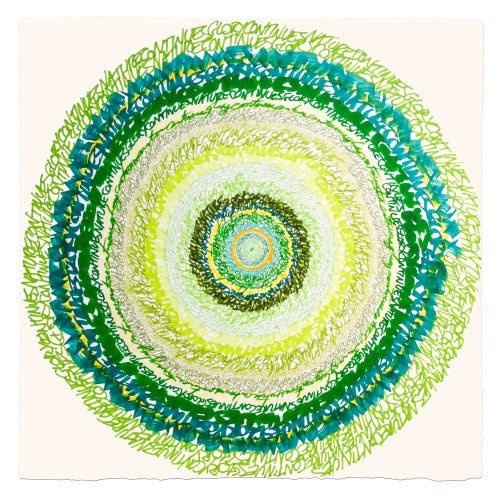
Susan Hable Smith and Steven L. Anderson took me down a meditative path at their exhibition “Leaves Of Grass,” on view at {Poem 88} Gallery through November 8. Anderson is the recipient of a 2014-15 Walthall Artist Fellowship and Hable Smith is the artist and designer behind the illustrative patterns and bold colored textiles of Hable Construction. In this two-person show, the artists immerse themselves in the natural terrene in order to lead the viewer on a journey of meditation, self-examination, and observation. While Anderson’s take is more macroscopic, Hable Smith zooms in on the contained beauty of her backyard garden in Athens, Georgia.
There are many parallels in the artists’ practices, including an unremitting attentiveness to our ecosystem and a palpable buzz of power in works that can only arise from working closely with nature. While Anderson could be described as a New Age virtuoso who channels his inner shaman to activate the viewer’s nervous system, Hable Smith creates pieces that are at once graphic and delicate, supplying their own recherché sparks. Anderson reveals the science behind nature through his artistic expression, while Hable Smith utilizes her experience to create an unforgettable synthesis of shapes and color in her collage, sculpture, drawing, printmaking, and painting. While Anderson has more pieces in this not-to-be missed show, both artists hold equal ground.
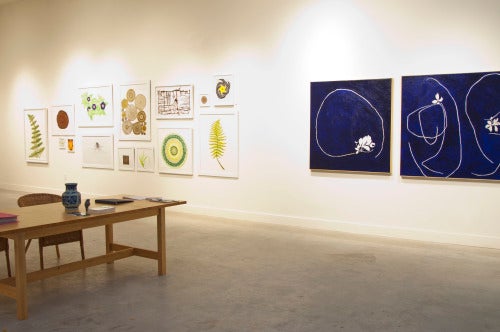
This show is named after Walt Whitman’s poetry collection “Leaves of Grass.” Whitman saw something more than a pretty picture in nature. He delved deeper to define his own state of being by understanding the language of nature. He hoped that by being attentive and reflective, he could glean knowledge from this natural world with the result of becoming a unique individual living a meaningful existence.
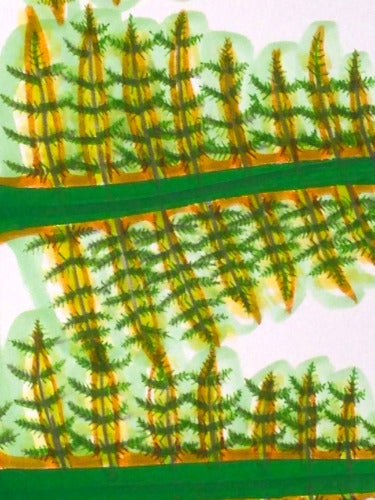
Anderson’s spiral configurations drew me in with their quiet hum of energy. His text-based circles and tree rings require your time and attention. The mantra “nature continues, glory continues,” a snippet taken from Whitman, repeats in Anderson’s marker and pen creation Energy Spiral—Nature Continues Glory Continues. The artist writes for hours, starting at the center of the circle and working out to the edge, making these artworks records of the private performances that he undertakes in the studio. The circinate images that don’t contain text allowed me to project my own ideas, thoughts, and mantras onto them. Anderson’s color choices bring to mind artist Josef Albers’s Interaction of Color theory. By placing one color next to another, Anderson creates new colors, in a way, because the combination skews each original hue.
How can a rendering of a fern be of great interest? Isolate it and make it iconic. In Fractal #6, I felt encouraged to explore the way a fern grows and behaves. There are originary branches that the artist branched off from. The art-making process is fractal, and the drawings gravitate towards a childlike whimsy. Upon taking a closer look at the branches and leaves of the plant, I was able to see emerald roads lined with trees. It is quite possible that another pair of eyes will see their own scenes nestled within the marks.
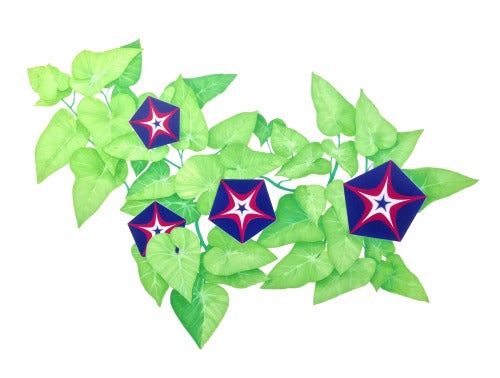
Anderson took me on a different kind of trip with works on paper made with marker and spray paint that depict flowers, such as Morning Glories and Dutora, which possess hallucinogenic properties. These blooms have psychedelic and spiritual connections in the way that humans have used them. The organic leaves in The Sisterhood of the Movement of the Free Spirit are at a sharp contrast with the graphic and geometrically flat Morning Glory petals that they appear almost as product logos.
You have to see in person the six photo transfers of caladium leaves by Hable Smith to understand the way she uses light to elevate what could seem like a delicate pressed flower to an near spiritual artifact. In caladium 6, the form resembles folded origami paper. This grouping of little gems with a piercing brilliance appeared to be jumping right off the page at me.
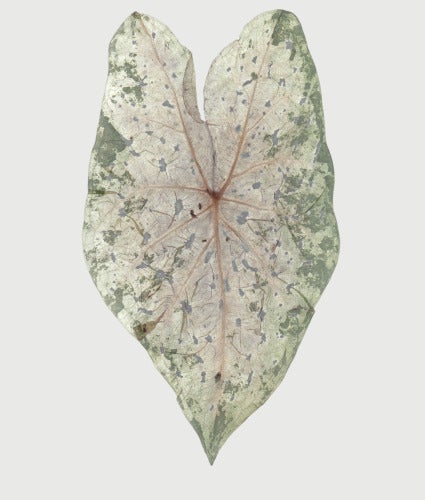
Hable Smith uses scale and scope to her advantage in her inky blue creations on linen in the strawberry vine series. Within these four large works I imagined a loose alphabet, a string playfully being pulled, and a sapphire eye with a white flower as iris. The artist bought an Yves Klein blue pigment from a vendor in Paris and mixed it with oil—the result transforming the notable color into a darker hue that is no less arresting. I kept thinking of the French navy-inspired classic blue and white striped shirts originally designed by Coco Chanel. The subtle variations in these off-kilter oceans of blue are best experienced up close. Their background shade allowed me to pay more attention to the shapes in each individual work. The images depict strawberry vines that were grown, picked, and pressed by the artist and her mother. Hable Smith’s joe pie weed brought to mind Ellsworth Kelly’s plant drawings, though this work’s grand size made me feel like I was about to step into an actual garden.
Hable Smith’s bold graphic works contrast nicely with Anderson’s labor-intensive drawings. Both artists are working in a very meditative way. The works share a connection in finding the spirit in the flora that surrounds us. This exhibition allows you to disconnect a bit from technology and reconnect with the natural world.
In conjunction with the exhibition, there will be a special event with artist Hope Hilton, “Order of the Third Bird Attention Lab,” on Saturday, November 8 at 1pm. Free, but RSVP required. Sherri Caudell is a poet and writer from Atlanta.